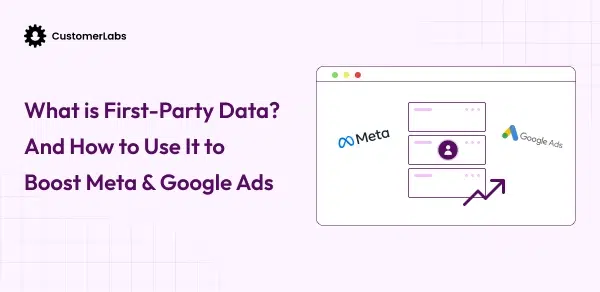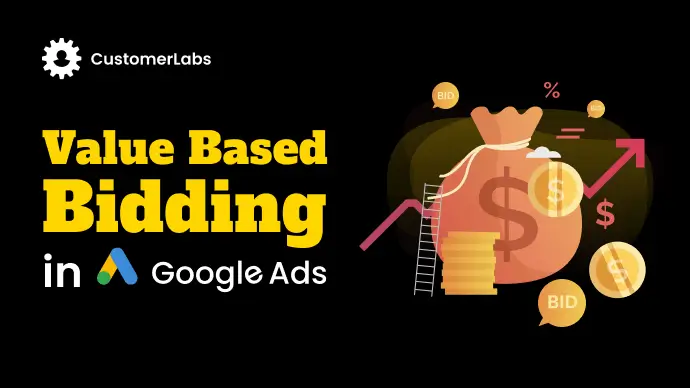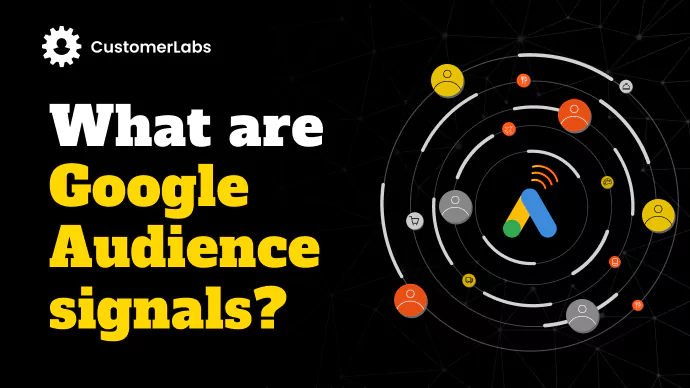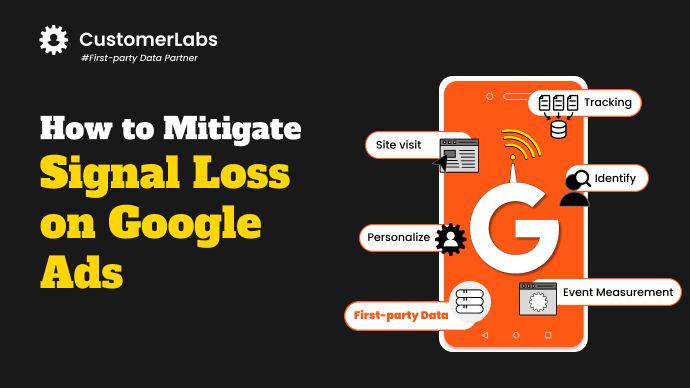
In the era of digital marketing, understanding your audience and their behavior is paramount. Google audience signals play a pivotal role in helping the algorithm understand the audience behavior. Signal loss in Google Ads has jolted the overall ad campaign performance. This blog delves into what audience signal loss is, its causes, and provides a comprehensive guide on strategies to mitigate signal loss in Google Ads.
Overview of Signal Loss in Google Ads
What are Google Audience Signals?
Google audience signal is the user behavior data and the user parameters that the ad platform collects from your website. The pixel on the browser-side, with the help of cookies, collects signals. The signals give the ad algorithms a complete picture of your customer journey to help you understand your customer better.
How will Google audience signals help?
Google audience signals give complete information about the high-intent audience to the ad algorithm. The ad algorithm will use these signals to target the right audience.
When the relevant audience looks at your ad that is personalized to them, they will click on the ad and convert. Automatically, your ad campaign performance shoots up.
The below screenshot from Google shows how the signals help expand your audience net.
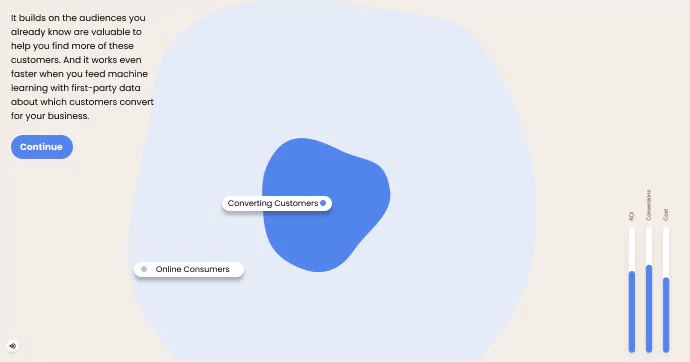
Source: Think With Google on How Automation Works
What is audience signal loss in Google Ads?
Signal loss means the audience data not being received effectively by Google Ads resulting in under-performing ad campaigns. It is basically the reduction in data that is sent to Google Ads from your website as a result of ineffectiveness of the browser pixel.
Audience signal loss leads to ineffective tracking that results in incomplete customer journey and ineffective measurement of ad campaigns as less data is available to the ad algorithm.
Causes of Audience Signal Loss in Google Ads
Data privacy laws such as the GDPR, CCPA, etc., iOS14.5+ updates, Android14 update, and the restriction on third-party cookies have caused signal loss.
In addition to the above, earlier Google also used to assign a click identifier called Google Click ID also known as Gclid to collect user data. After the recent iOS updates, it’s difficult for advertisers to collect Gclid. Once again, Google Ads cannot collect the user data, causing attribution problems, the major issue for marketers.
In response to the lack of Gclid, Google has come up with two new parameters GBRAID and WBRAID to mitigate for the loss of Gclid.
The below image shows how signal loss occurs in Google Ads and its impact.
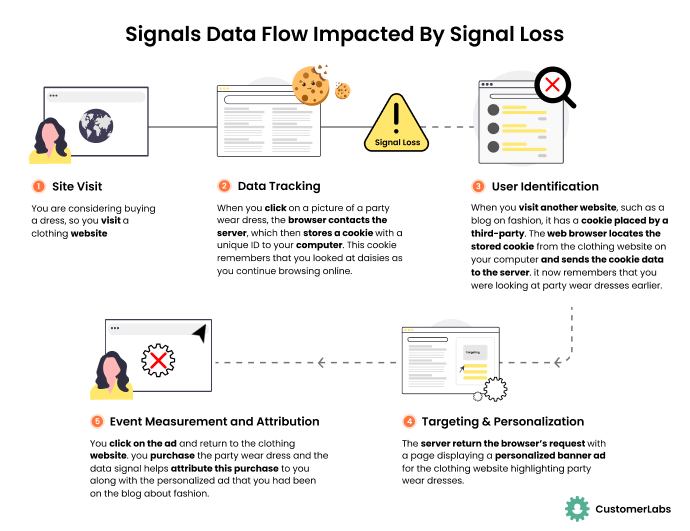
Starting 2025, the digital ecosystem will be fully data privacy-centric. The same third-party cookies that helped the ad platforms collect the signals earlier are now devoid of valuable customer data due to the cookie deprecation and data privacy updates.
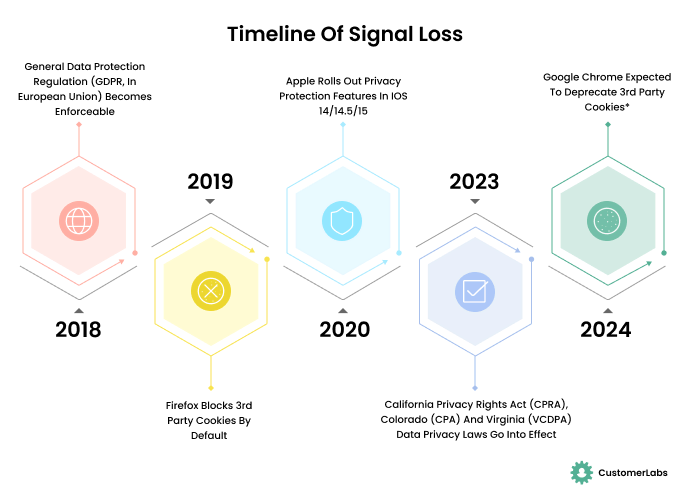
Impact of signal loss in Google Ads
Signal loss in Google Ads has a tremendous impact on some of your existing marketing strategies. Some of those strategies that are impacted by signal loss due to cookies and iOS14+ updates among others are:
1. Cross-site Tracking
You can no longer use cross-site tracking to understand your audience behavior on other sites and target them based on it. For example, earlier if a user visited a blog on fashion, and then visited your website and now again goes to a different fashion website, based on all this data, you can target the user with a personalized ad that shows the products he viewed on your website. Now, without browser cookies, it is not possible.
2. Targeting & Retargeting
Now, if a user visited your website 45 days ago, and now again visited today, you will not know if it is the same user. It is again a new user. When you do not even have the data of the users stored,
- You cannot retarget them based on their previous behavior
- You do cannot have a complete understanding of your users that leads to inefficient targeting
3. Lookalike Modeling
With lack of audience data, you cannot have rich audience behavior to use lookalike modeling to expand your audience net to find new users who are similar to your existing high-intent users.
4. Performance Measurement & Attribution
When the user data is not collected from the ad, it is not possible to match that user with the converted customer and attribute them to the ad campaign. This leads to the gaps in attribution giving inaccurate ad campaign performance.
5. Frequency Capping
Ideally, Google Ads allows you to cap a frequency, i.e., showing ads not more than the cap set up. For example, if you cap the frequency at 2, Google Ads will not show the same ad to that person for more than 2 times. But, when the data of first-view is not captured, the ad algorithm will again show the ad to that person as it does not have the data if the person viewed the ad already.
6. Google Ads Platform Optimization
The Google Ads algorithm analyzes the data across all your ad campaigns and tries to optimize your future campaigns based on the previous results. Now, when the data isn’t collected by the browser cookie effectively, it cannot optimize the ad platform thus minimizing your ad campaign performance.
Apart from the above, multi-touch attribution, view-through attribution, website & email personalization are also impacted due to signal loss.
Contextual targeting, cohort-based targeting, and media mix modeling are the least impacted by signal loss.
How to mitigate signal loss in Google Ads?
Impact you see from signal loss might be unique to every business. So, you need to see and understand what is the actual impact you face by signal loss in Google Ads.
Here’s the perfect step by step guide that helps you mitigate signal loss in Google Ads:
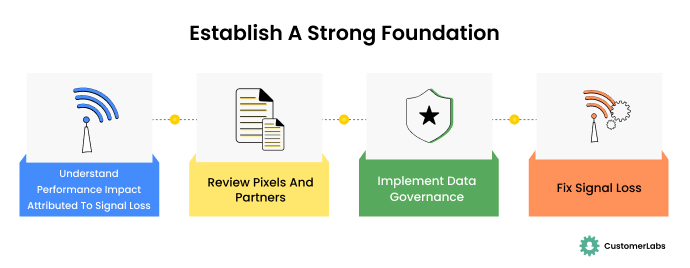
Step 1: Understand the impact:
Analyze the existing data to find the changes in the metrics as compared to the pre-iOS14 era and before third-party cookies became history.
Step 2: Audit the data sources and aggregations:
Audit the changes that your agencies or partners are incorporating to tackle the impact of signal loss. If you already have any TechStack, see if it is able to help you mitigate the impact of signal loss in Google Ads.
Step 3: Review Pixels and Partners
Evaluate the extent to which the signal loss is taking place and how poorly the pixels are configured among your partners. If your partners are already helping you collect first-party data, evaluate the strategy they are using, to ensure the signals are resilient.
Step 4: Data Governance
Implement consent management to ensure proper user data privacy framework is in place that helps you with the user consent management and data privacy regulations.
Step 5: Fix Signal Loss in Google Ads
Set up conversion tracking and opt for Google enhanced conversions to measure your ad campaign performance better. Google has come up with GBRAID, a parameter that is more user privacy-centric and is more accurate in tracking conversions. Although it does not aid you in identifying the user, it does solve the attribution problem to a major extent.
Google offline conversion import will help you tell Google Ads, who are converted and who are not, for a lead-gen business. Here’s the detailed Offline Conversion Import Helper guide.
Doing so, you can improve your attribution, ad targeting and prevent signal loss.
Implement server-to-server API connections and other advanced future-proof-technologies to fix the signal loss.

Where are you in the Signal Loss Maturity Curve?
The below image shows the four stages of digital maturity and what stages most businesses lie in. The businesses that are in the first & second stages are the ones that are most impacted by the signal loss. If you are facing a moderate signal loss, that means you are in the second stage. See for yourself, which stage of digital maturity you fall in.
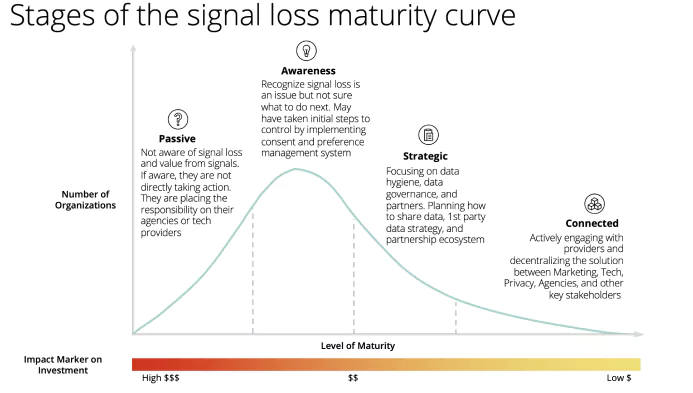
Source: Signal Resiliency Guide by Deloitte Digital
Conclusion:
The future of the digital ad ecosystem is going to be cookieless and privacy-centric. You need to adapt to the new methods that help you increase your ad campaign performance. Implementing server-side API, Google Enhanced Conversions, Aggregated Event Measurement method, Anonymizing the data and sending it to ad platforms, are some of the ways that help you mitigate signal loss to Google Ads.
To reduce the Google signal loss, first-party data is the way out. Collect your own first-party data on the server-side and focus on helping the ad algorithm to understand your audience better.
Additional Tips:
- Implement consent-based tracking to collect first-party data
- Use forms on the website to collect the user information
- Have post-purchase surveys to collect information directly from the customers to increase your attribution
- Use first-party data to personalize ad experience using Google retargeting and lookalike audiences.
- Use contextual advertising and a privacy-centered attribution modeling
- Stack up with privacy-enhancing technologies
- Personalize but don’t too much
- Create media plans using cohort-based targeting strategy

